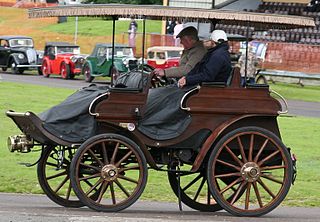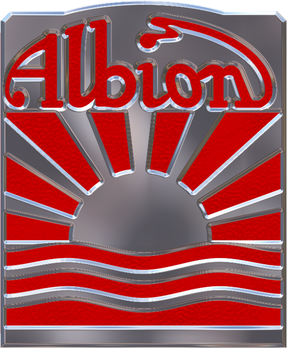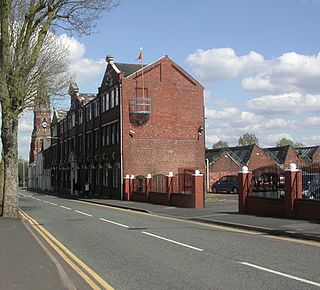
AC Cars, originally incorporated as Auto Carriers Ltd., is a British specialist automobile manufacturer and one of the oldest independent car makers founded in Britain. As a result of bad financial conditions over the years, the company was renamed or liquidated many times until its latest form. In 2022, the new corporate structure began the production of new AC Cobra models, with a slightly modified structure to adapt it to modern safety and technology requirements and obtain the European road homologation certificate.

A four-wheel drive, also called 4×4 or 4WD, is a two-axled vehicle drivetrain capable of providing torque to all of its wheels simultaneously. It may be full-time or on-demand, and is typically linked via a transfer case providing an additional output drive shaft and, in many instances, additional gear ranges.

Arrol-Johnston was an early Scottish manufacturer of automobiles, which operated from 1895 to 1931 and produced the first automobile manufactured in Britain. The company also developed the world's first "off-road" vehicle for the Egyptian government, and another designed to travel on ice and snow for Ernest Shackleton's Nimrod Expedition to the South Pole.
Brush Traction was a manufacturer and maintainer of railway locomotives in Loughborough, England whose operations have now been merged into the Wabtec company's Doncaster UK operations.

De Dion-Bouton was a French automobile manufacturer and railcar manufacturer, which operated from 1883 to 1953. The company was founded by the Marquis Jules-Albert de Dion, Georges Bouton, and Bouton's brother-in-law Charles Trépardoux.
The Wayne Corporation was an American manufacturer of buses and other vehicles under the "Wayne" marque. The corporate headquarters were in Richmond, Indiana, in Wayne County, Indiana. During the middle 20th century, Wayne served as a leading producer of school buses in North America.

The CitiCar is a car produced from 1974 to 1977 by Sebring, Florida–based Sebring-Vanguard, Inc. After being bought out by Commuter Vehicles, Inc, Sebring-Vanguard produced the similar Comuta-Car and Comuta-Van from 1979 to 1982. Similarities to its exterior design can be spotted in the Danish Kewet and the later Norwegian Buddy electric car. Accounting for all CitiCar variants, a total of 4,444 units were produced up to 1979, the most since 1945 for an electric car assembled in North America until surpassed in 2011 by the Nissan Leaf.

Thornycroft was an English vehicle manufacturer which built coaches, buses, and trucks from 1896 until 1977.

Albion Motors was a Scottish automobile and commercial vehicle manufacturer.

Guy Motors was a Wolverhampton-based vehicle manufacturer that produced cars, lorries, buses and trolleybuses. The company was founded by Sydney S. Guy (1885–1971) who was born in Kings Heath, Birmingham. Guy Motors operated out of its Fallings Park factory from 1914 to 1982, playing an important role in the development of the British motor industry.

Granton is a district in the north of Edinburgh, Scotland. Granton forms part of Edinburgh's waterfront along the Firth of Forth and is, historically, an industrial area having a large harbour. Granton is part of Edinburgh's large scale waterfront regeneration programme.
Pilton is a residential area of northern Edinburgh, Scotland. It is to the north of Ferry Road, immediately east of Muirhouse, and to the west and south of Granton.

The Maudslay Motor Company was a British vehicle maker based in Coventry. It was founded in 1901 and continued until 1948 when it was taken over by the Associated Equipment Company (AEC) and along with Crossley Motors the new group was renamed Associated Commercial Vehicles (ACV) Ltd.
Headland Archaeology Ltd is a wholly owned subsidiary of the RSK Group. Headland provides archaeological services and heritage advice to the construction industry.

Durant-Dort Carriage Company was a manufacturer of horse-drawn vehicles in Flint, Michigan. Founded in 1886, by 1900 it was the largest carriage manufacturer in the country.

Clément-Panhard is an automobile designed in 1898 by Arthur Constantin Krebs, manager of Panhard & Levassor co, from his 1896 patent of a car fitted with an electromagnetic gearbox, whose licence was acquired by Émile Levassor.
Events from the year 1898 in Scotland.

Tver Carriage Works is a rolling stock manufacturer located in Tver, Russia. The company is part of Transmashholding.

Sunbeam Commercial Vehicles was a commercial vehicle manufacturing offshoot of the Wolverhampton based Sunbeam Motor Car Company when it was a subsidiary of S T D Motors Limited. Sunbeam had always made ambulances on modified Sunbeam car chassis. S T D Motors chose to enter the large commercial vehicle market in the late 1920s, and once established they made petrol and diesel buses and electrically powered trolleybuses and milk floats. Commercial Vehicles became a separate department of Sunbeam in 1931.

















